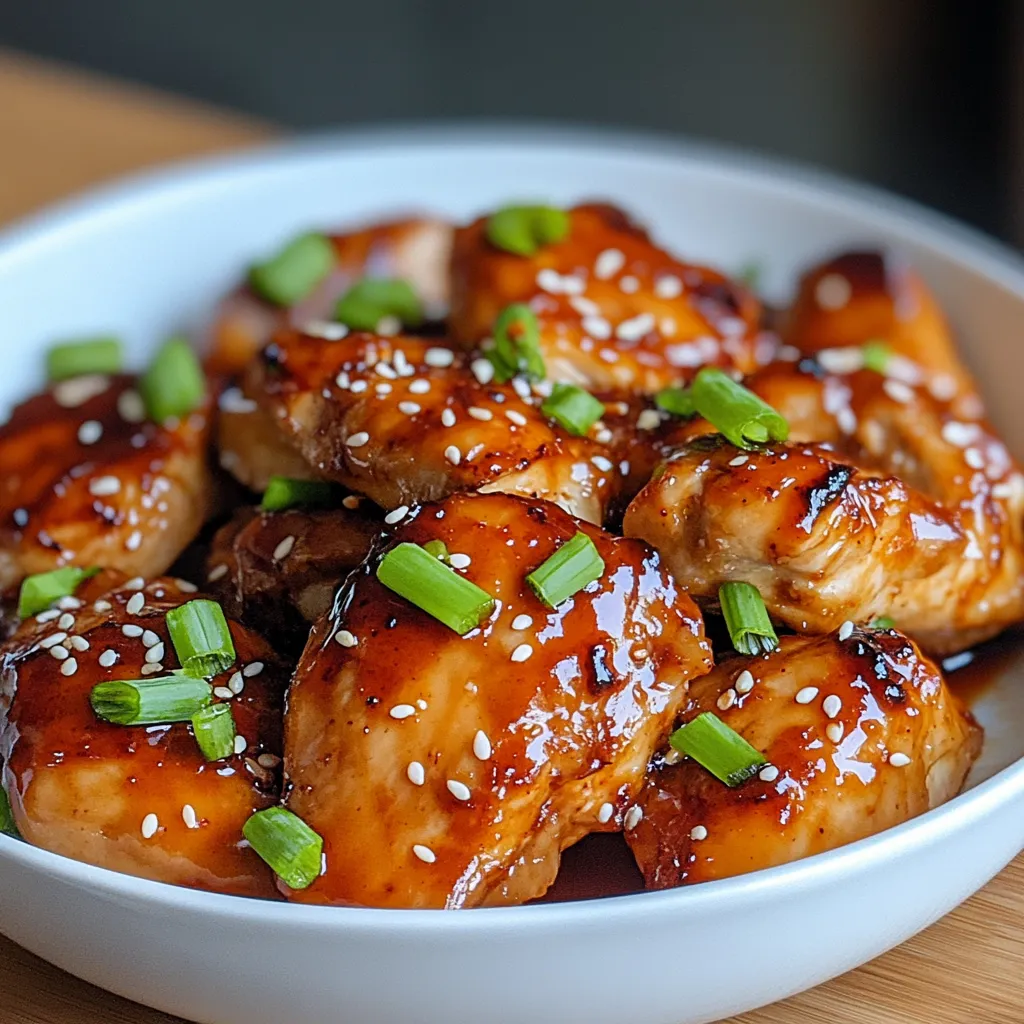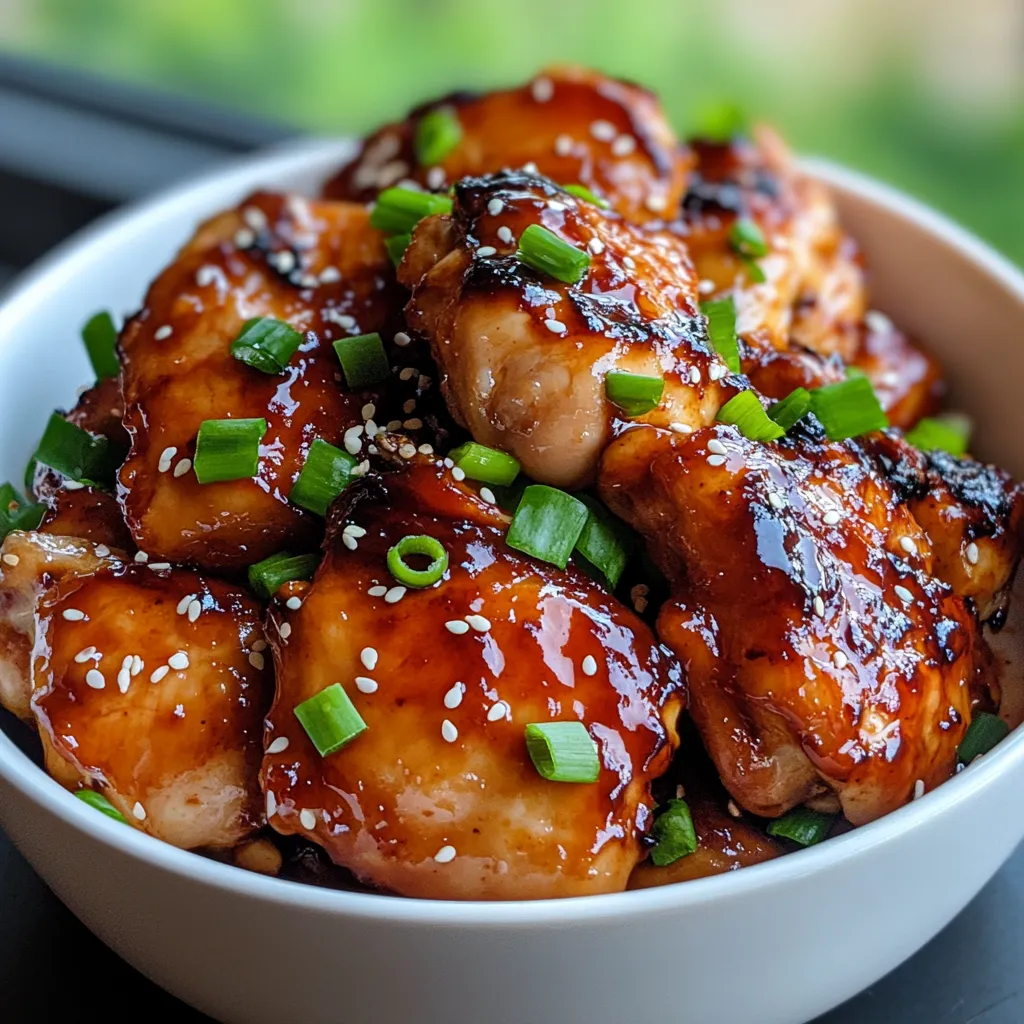 Bookmark
Bookmark
This sticky honey gochujang chicken delivers the perfect balance of sweet, spicy and savory flavors in one irresistible dish. The chicken stays tender inside while developing a deliciously crisp exterior, all coated in a glossy, sticky sauce that will have everyone reaching for seconds.
I first made this dish when craving something different from our usual dinner rotation, and it quickly became my family's most requested meal. The way the honey caramelizes with the gochujang creates this incredible sauce that's impossible to resist.
Ingredients
- Boneless skinless chicken thighs the dark meat stays juicy and tender while standing up to the bold flavors
- Cornstarch creates that perfect light crispy coating that helps the sauce cling to every bite
- Gochujang Korean chili paste that provides complex sweet, savory and spicy flavors all in one ingredient
- Honey balances the heat while creating that sticky glaze we crave
- Rice vinegar adds brightness and cuts through the richness
- Sesame oil a finishing touch that adds nutty depth to the sauce
- Fresh ginger and garlic aromatic foundations that make the dish sing
Step-by-Step Instructions
- Prepare the Chicken
- Season chicken pieces with salt and pepper before tossing with cornstarch. This seasoning penetrates the meat while the cornstarch creates a protective barrier that keeps moisture in and helps develop a golden exterior. Make sure pieces are evenly sized about 1-inch cubes for optimal cooking and sauce coverage.
- Cook the Chicken
- Heat your pan until it's properly hot before adding oil this ensures immediate searing rather than steaming. Resist the urge to stir constantly allowing the chicken to develop a golden crust on one side creates texture contrast and deeper flavor. Watch for the chicken to turn opaque and reach 165°F internally before removing from the pan.
- Make the Sticky Sauce
- Use the same pan to build layers of flavor starting with aromatics. The residual chicken bits deglaze into the sauce creating deeper umami notes. Keep the heat medium to prevent burning the garlic and ginger which would introduce bitterness. The sauce will look thin at first but will thicken as it simmers and reduces.
- Coat the Chicken in Sauce
- Return chicken to the sauce while still hot to ensure maximum absorption. Gently fold rather than stir vigorously to preserve the coating you worked to create. The sauce should coat the back of a spoon before adding the chicken back in this indicates the perfect consistency.
- Garnish and Serve
- Add garnishes just before serving to maintain their fresh color and texture. The sesame seeds add visual appeal and nutty crunch while the green onions bring freshness and color contrast to the rich dish.
 Bookmark
Bookmark
My favorite part of this recipe is watching how the sauce transforms from separate ingredients into a glossy, vibrant glaze that clings to every piece of chicken. I once served this at a dinner party, and a friend who claimed to dislike spicy food couldn't stop eating it the balanced flavors won her over completely.
Serving Suggestions
This sticky chicken pairs beautifully with steamed white rice which soaks up the extra sauce perfectly. For a complete meal, add a simple cucumber salad dressed with rice vinegar and a sprinkle of sesame seeds. The cool, crisp cucumber provides a refreshing contrast to the rich, spicy chicken. You could also serve it with butter lettuce leaves for a fun lettuce wrap option that adds a fresh crunch.
Make Ahead and Storage
You can prepare the sauce up to 3 days ahead and store it in an airtight container in the refrigerator. The chicken is best cooked fresh, but leftovers will keep for up to 4 days refrigerated. To reheat, add a splash of water to the pan to loosen the sauce as it warms. The flavors actually develop overnight, making this an excellent meal prep option that tastes even better the next day.
Ingredient Substitutions
No gochujang? You can substitute with 1 tablespoon sriracha mixed with ½ teaspoon miso paste and ½ teaspoon brown sugar. If chicken thighs aren't available, chicken breasts will work but watch cooking time carefully to prevent drying out. Maple syrup can replace honey for a slightly different but equally delicious sweetness. For a gluten-free version, use tamari instead of soy sauce.
Recipe FAQs
- → What is gochujang and can I substitute it?
Gochujang is a Korean fermented red chili paste with a sweet, spicy, and umami flavor profile. If unavailable, you can substitute with a mixture of 1 tablespoon sriracha, 1/2 tablespoon miso paste, and 1/2 teaspoon brown sugar, though the authentic flavor will differ slightly.
- → Can I use chicken breast instead of thighs?
Yes, chicken breast can be substituted for thighs, but be careful not to overcook as it can dry out more easily. Reduce the cooking time by 1-2 minutes and consider marinating the breast meat briefly in a tablespoon of soy sauce before cooking to help maintain moisture.
- → How spicy is this dish?
The spice level is moderate, as the honey balances the heat from the gochujang. For a milder version, reduce the gochujang to 1 tablespoon. To increase the heat, add 1/2-1 teaspoon of Korean red pepper flakes (gochugaru) or a dash of sriracha to the sauce.
- → What sides pair well with this chicken?
This chicken pairs excellently with steamed white rice, which helps balance the bold flavors. Other great options include quick-pickled vegetables, kimchi, stir-fried bok choy, or a simple cucumber salad dressed with rice vinegar and sesame oil.
- → Can I make this dish ahead of time?
Yes, you can prepare this dish up to 2 days ahead. The flavors actually deepen overnight. Store in an airtight container in the refrigerator and reheat gently in a skillet with a splash of water to restore the sauce's consistency. Add fresh garnishes just before serving.
- → Is there a way to make this dish gluten-free?
To make this dish gluten-free, substitute regular soy sauce with tamari or certified gluten-free soy sauce. Also check your gochujang, as some brands contain wheat; look specifically for gluten-free gochujang or make a substitute using gluten-free ingredients.
